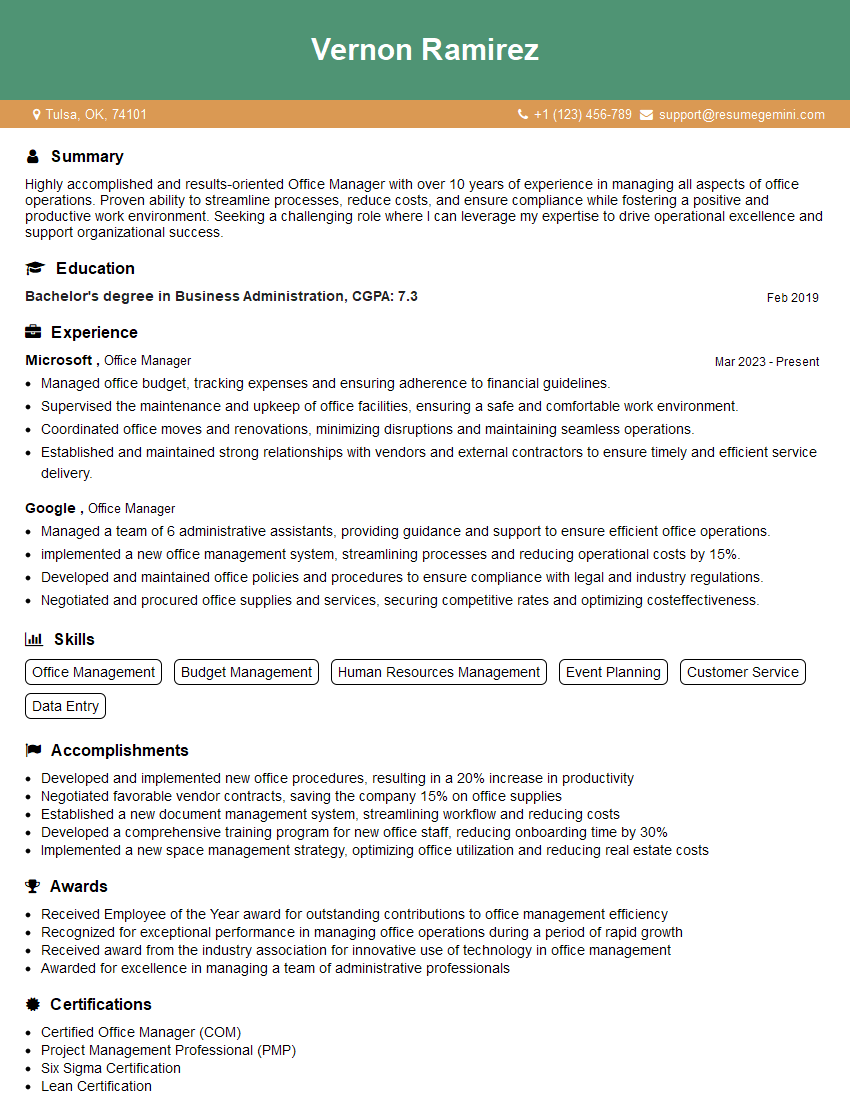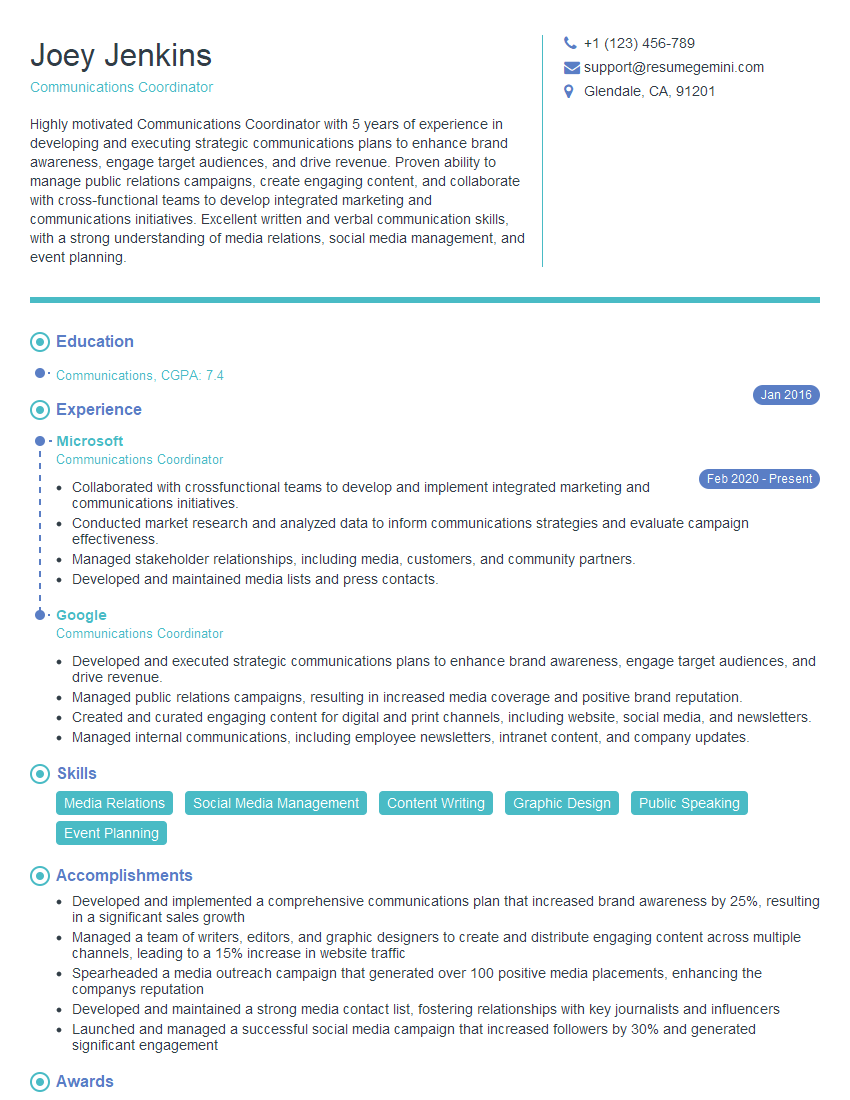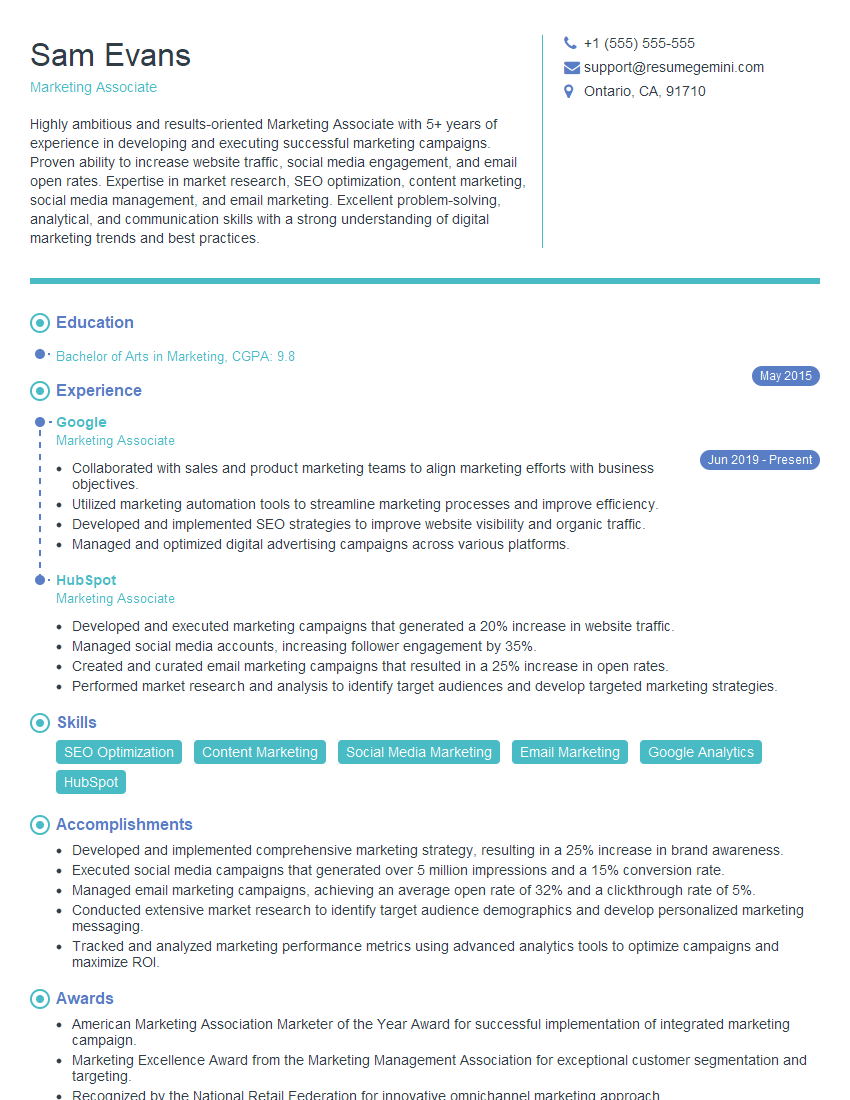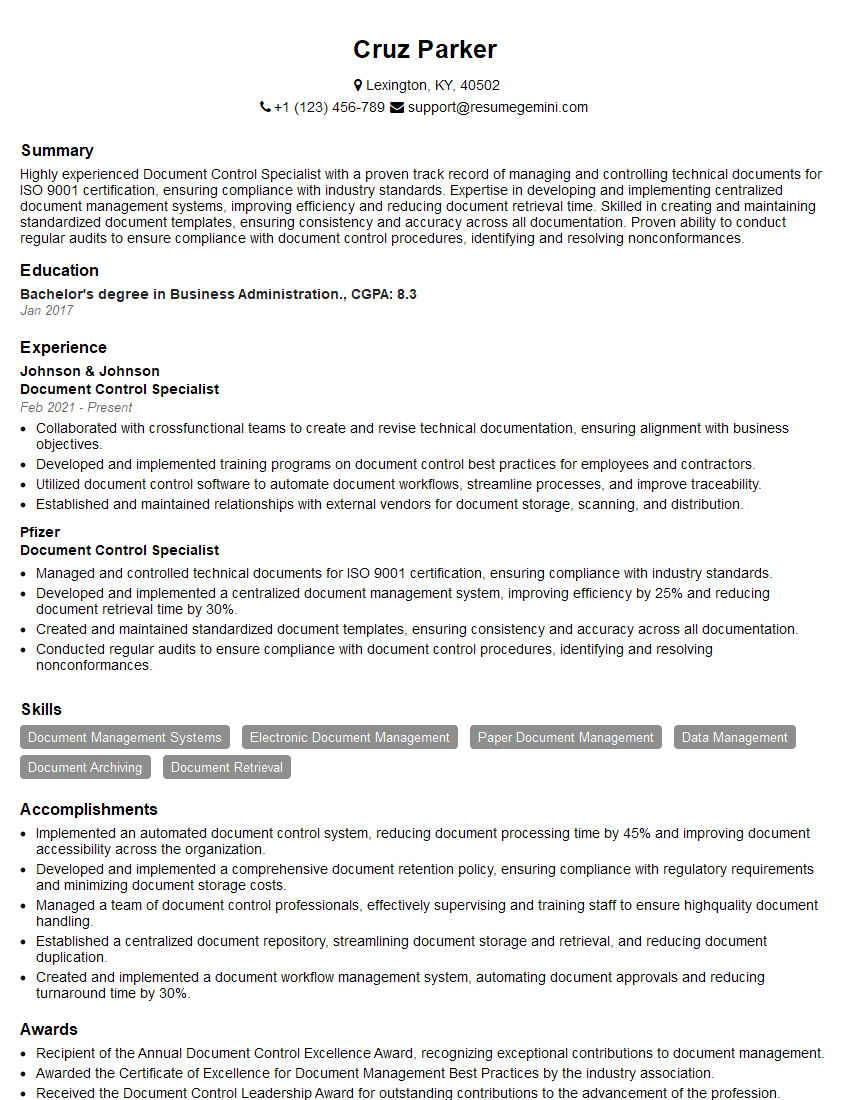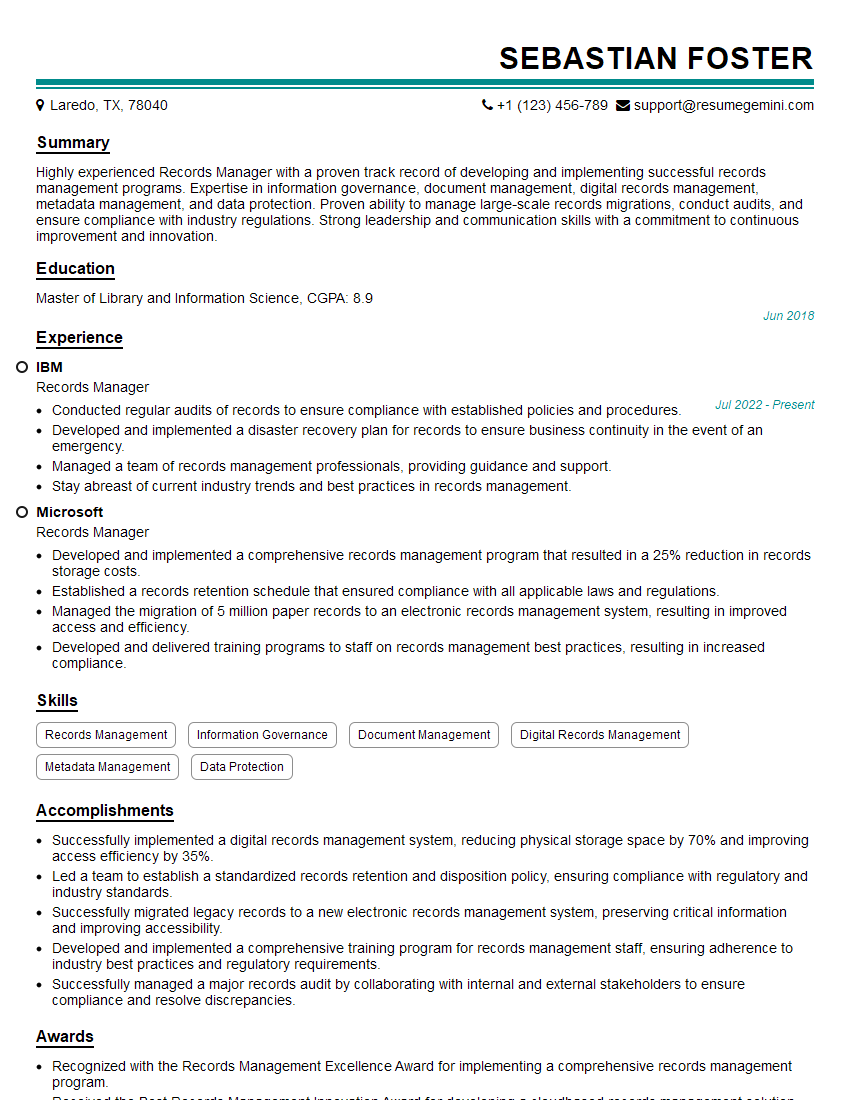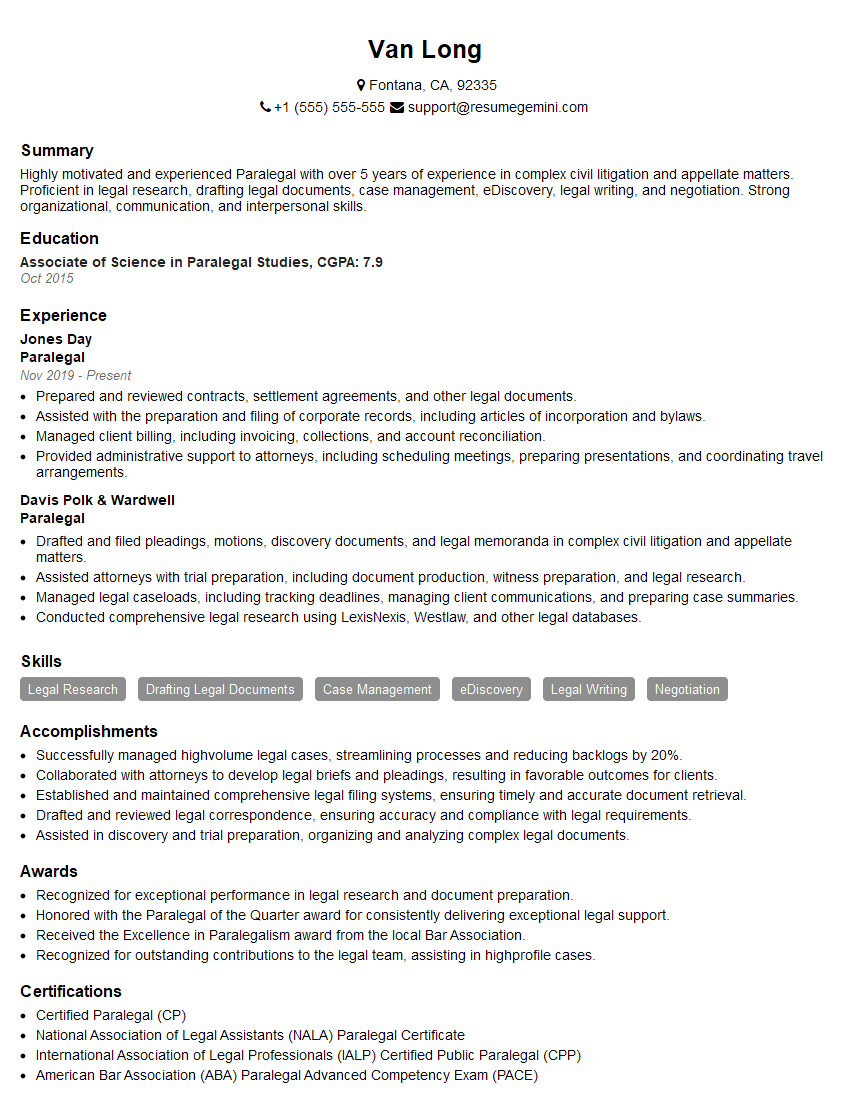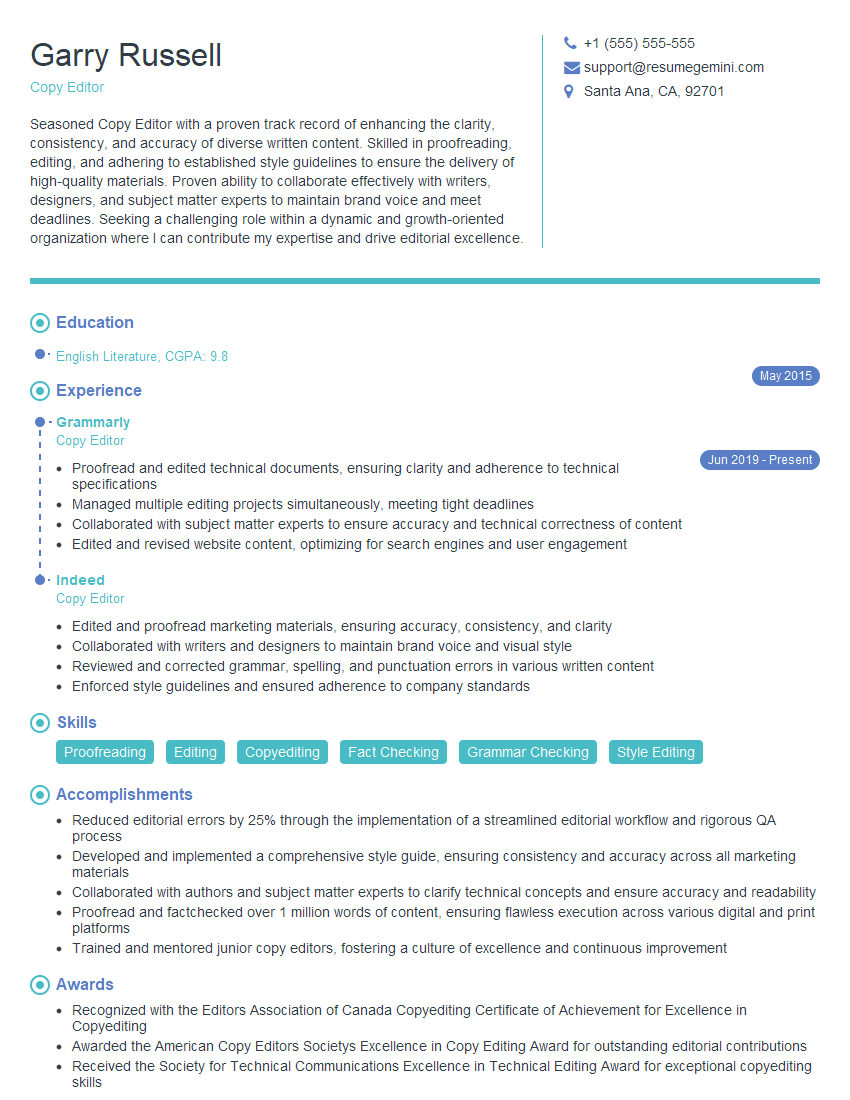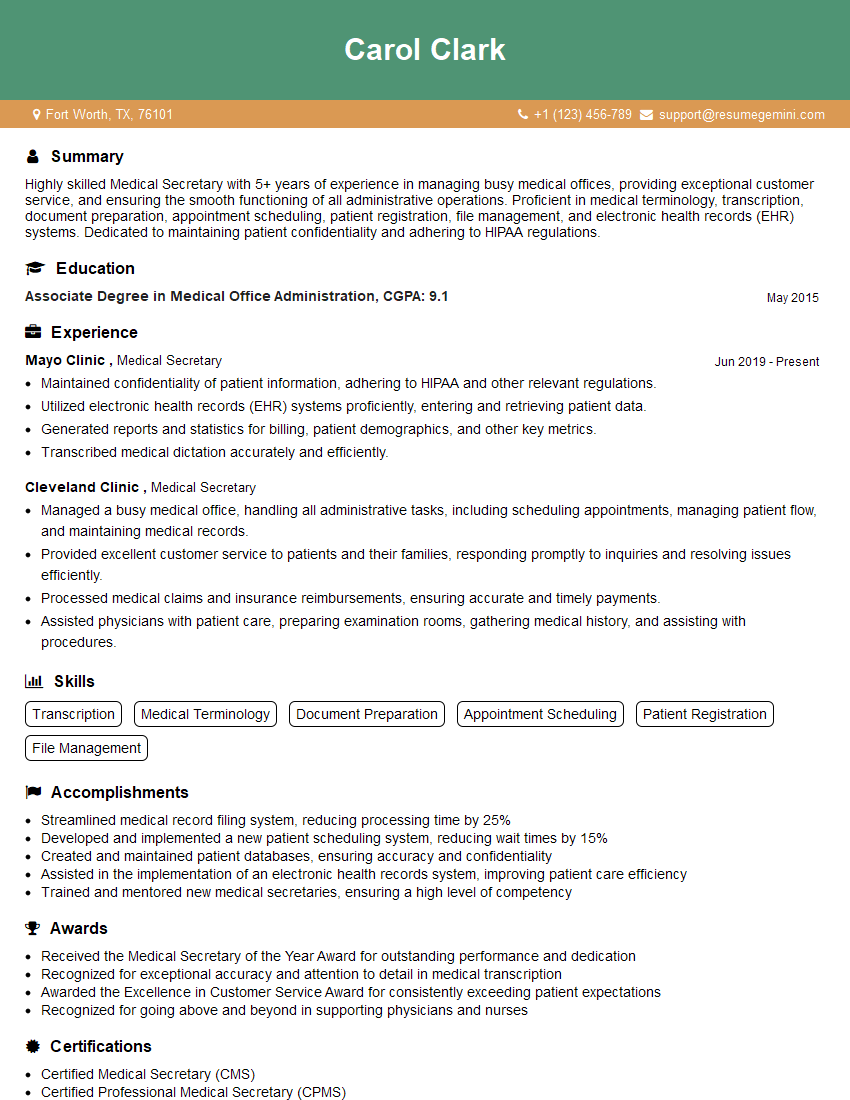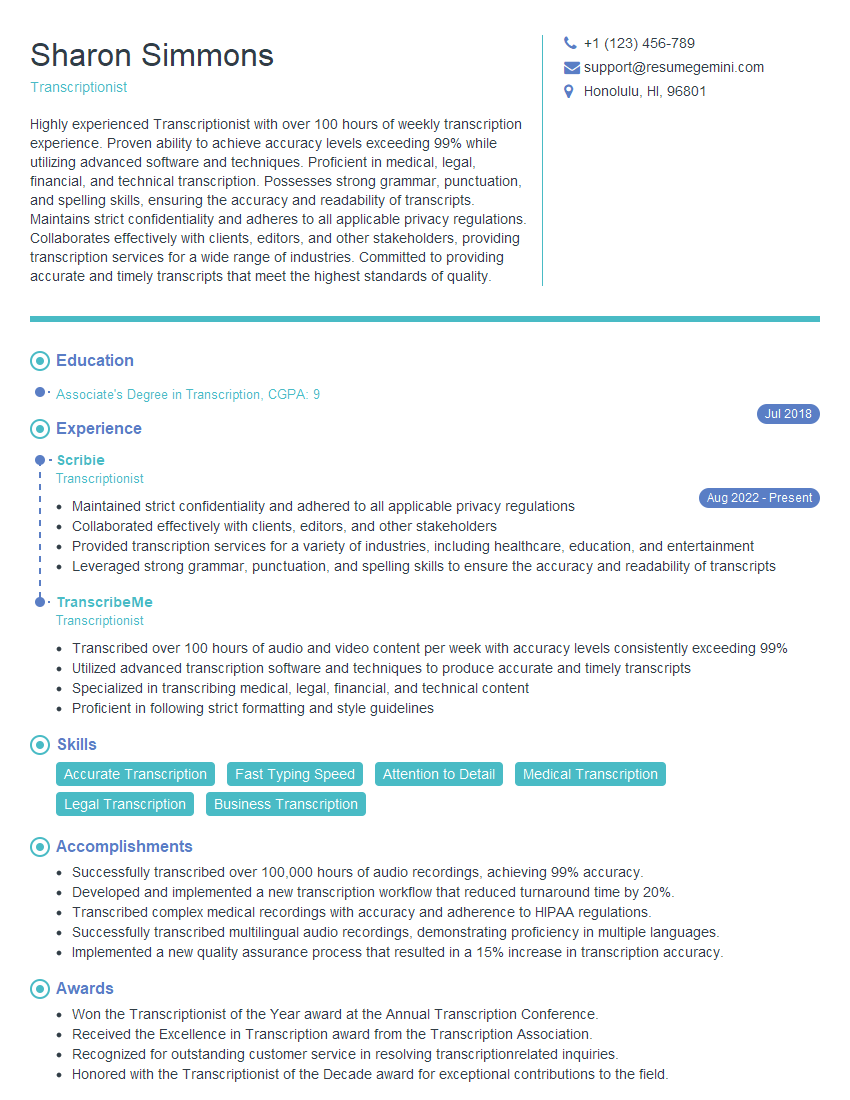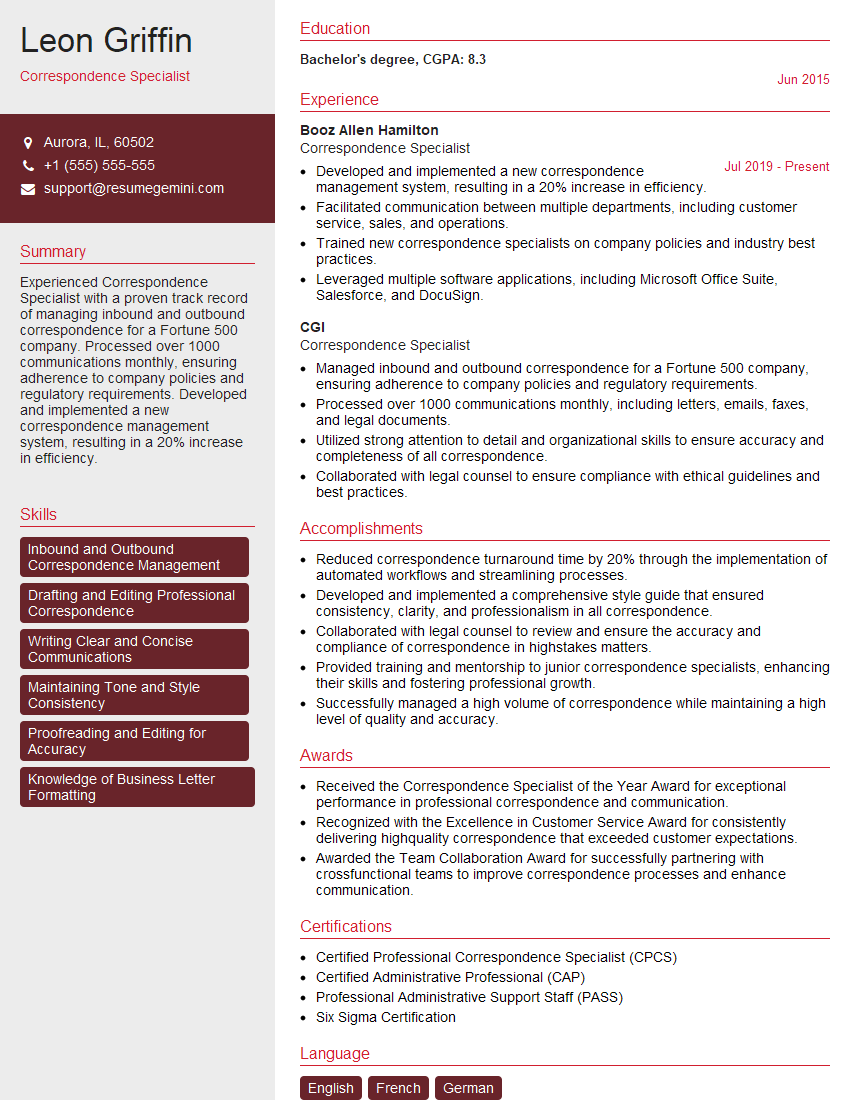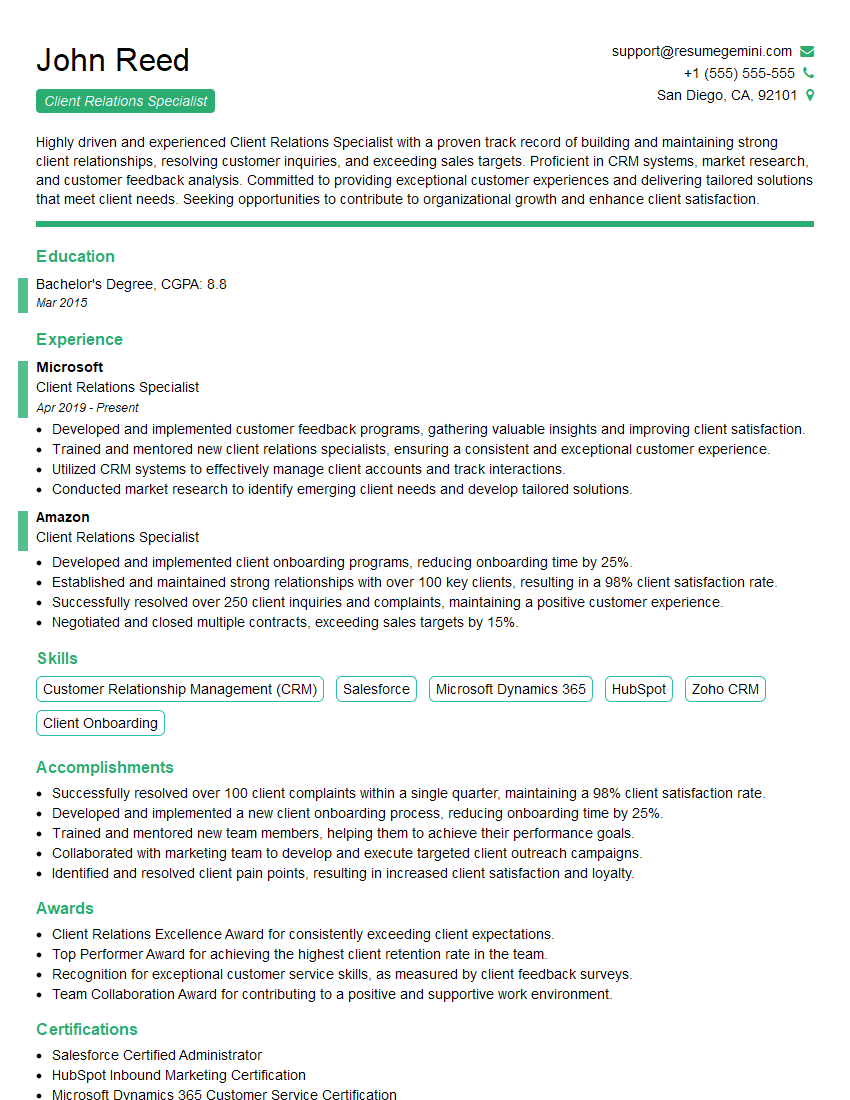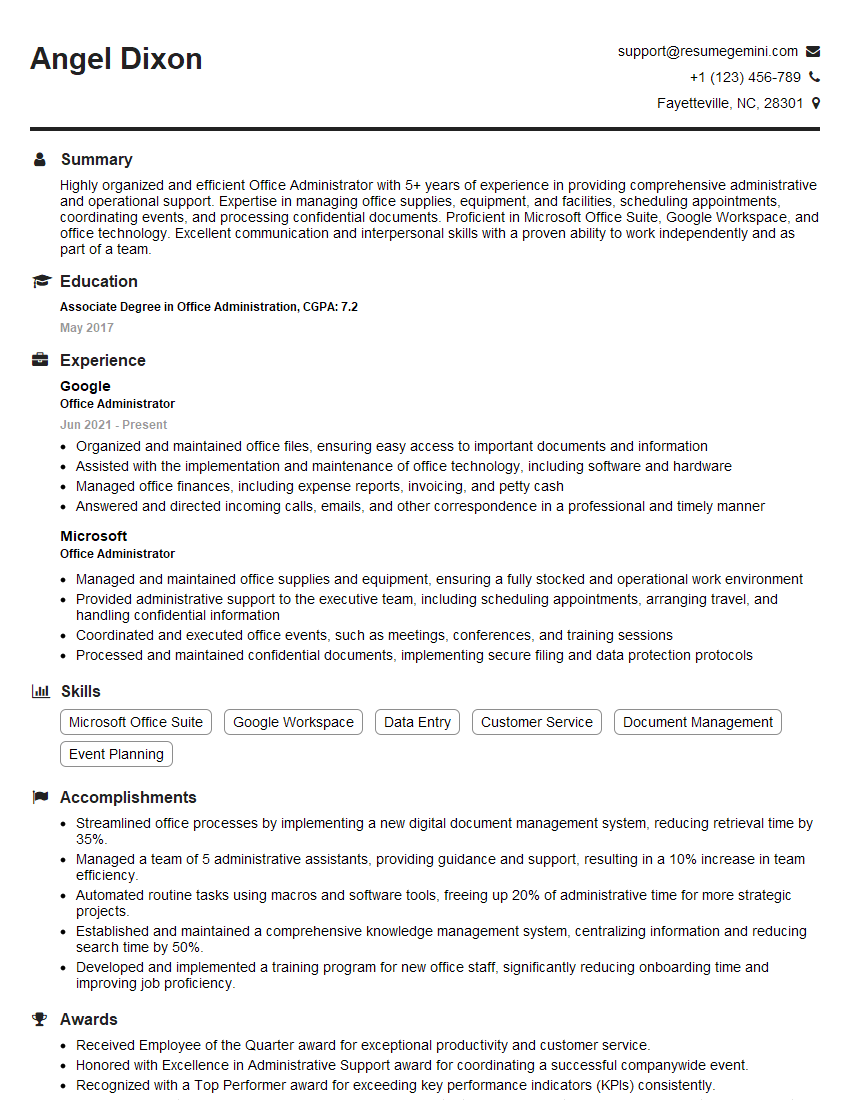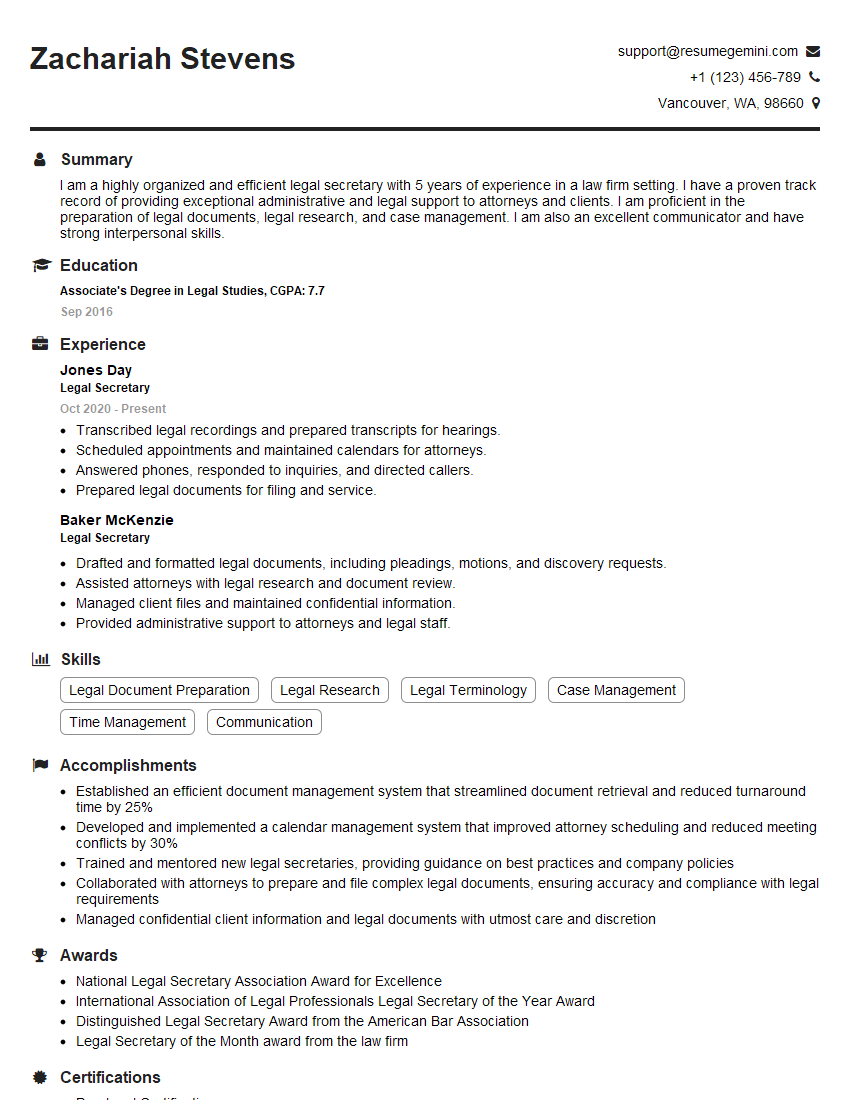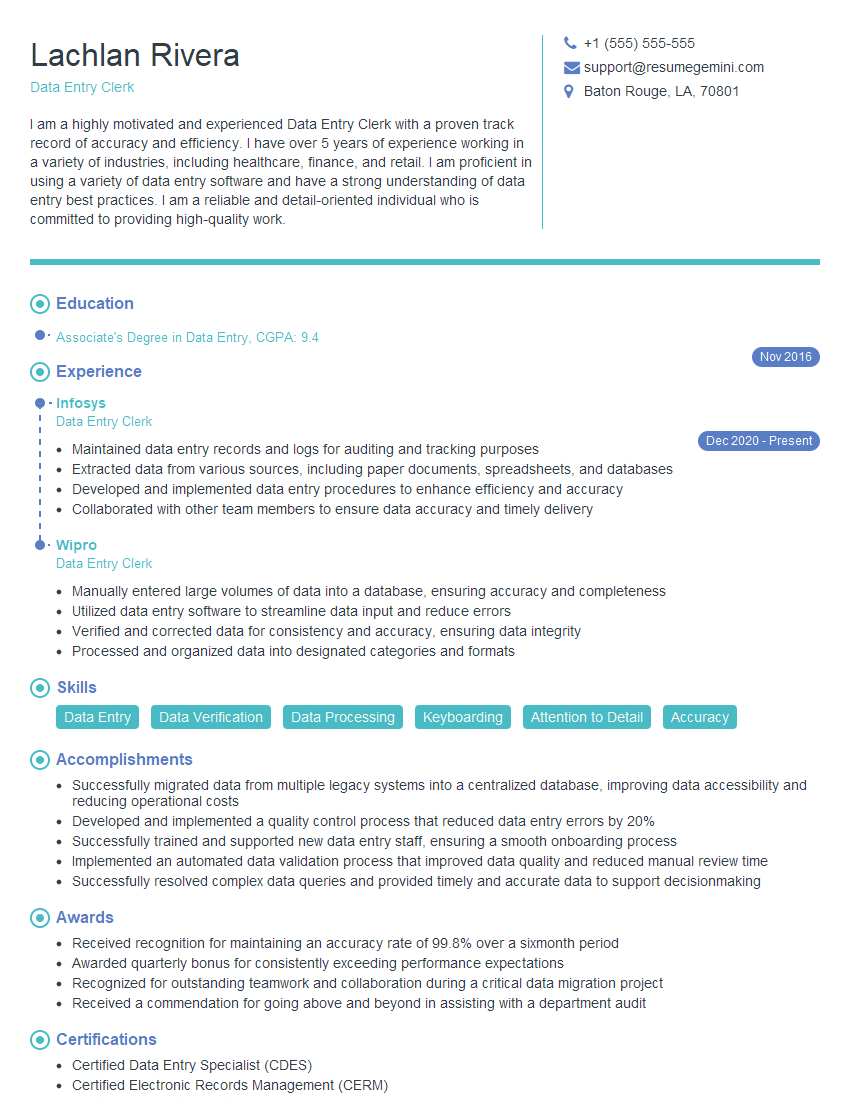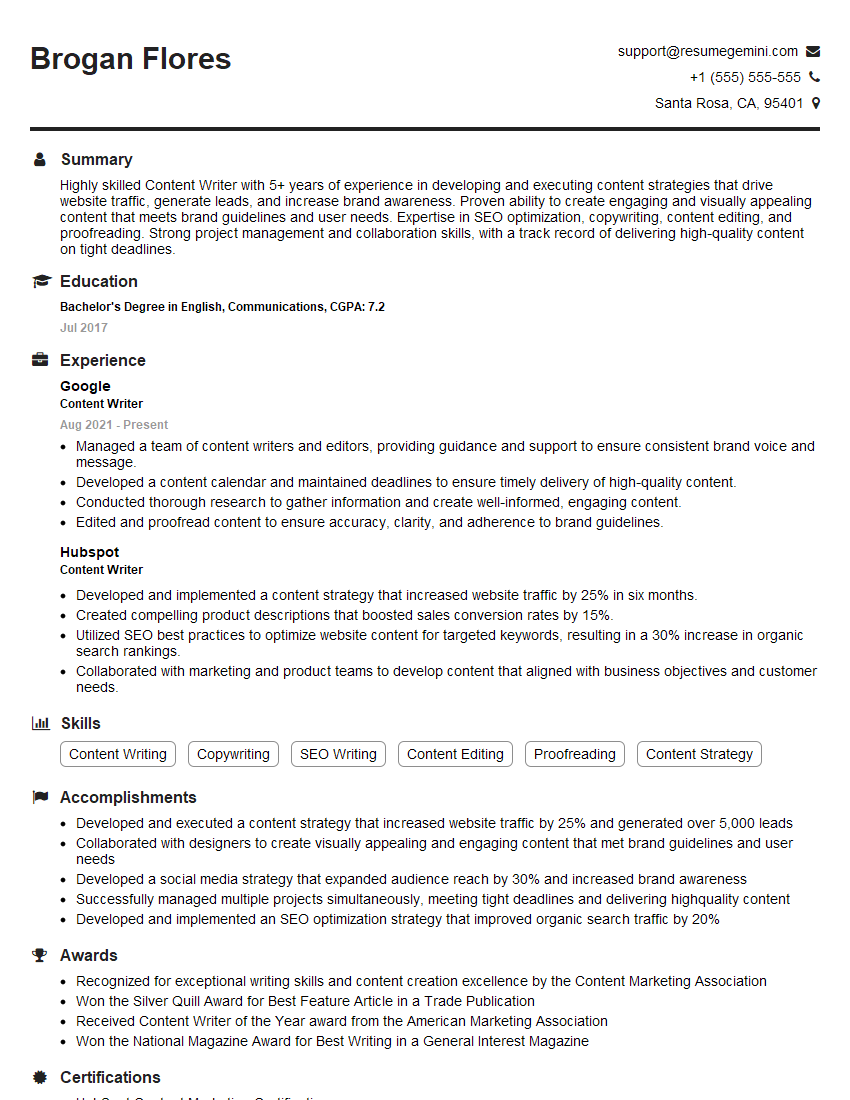The thought of an interview can be nerve-wracking, but the right preparation can make all the difference. Explore this comprehensive guide to Correspondence Preparation interview questions and gain the confidence you need to showcase your abilities and secure the role.
Questions Asked in Correspondence Preparation Interview
Q 1. Explain your process for prioritizing correspondence.
Prioritizing correspondence involves strategically managing incoming and outgoing communications to ensure timely and effective responses. I use a system that combines urgency, importance, and impact.
- Urgency: Items requiring immediate attention, like time-sensitive requests or critical client issues, are prioritized first. Think of it like a hospital triage system – the most critical cases get immediate attention.
- Importance: This considers the overall significance of the communication. For example, a request from a major client holds more weight than a routine inquiry.
- Impact: This assesses the potential consequences of delaying a response. A complaint about a faulty product requires a swift response to mitigate reputational damage.
I often utilize a task management system, either digital or physical, to list correspondence items, assigning priority levels (e.g., high, medium, low) and deadlines. This allows for a clear overview and efficient workflow, ensuring nothing slips through the cracks. For instance, I might use color-coding in my calendar to visually distinguish high-priority items.
Q 2. Describe your experience with different correspondence formats (email, letter, memo).
My experience spans various correspondence formats, each tailored to specific contexts.
- Email: The most common format for internal and external communication, particularly for quick updates, informal discussions, and sharing documents. I’m adept at crafting concise, clear emails, using appropriate subject lines and salutations, and maintaining a professional tone. For example, I carefully choose when to use “Reply All” to avoid overwhelming recipients.
- Letters: Used for more formal occasions, such as client announcements, official notifications, or expressions of gratitude. I pay close attention to the tone, ensuring it reflects the desired level of formality and professionalism. For instance, a formal letter to a government agency would require a different approach than a thank-you note to a colleague.
- Memos: Primarily for internal communication, memos are effective for disseminating information within an organization. I ensure memos are concise, well-organized, and include a clear purpose, audience, and action items. For example, a memo announcing a company policy change should be structured logically and include all relevant details.
My ability to seamlessly transition between these formats is crucial for effective communication in diverse settings. I adapt my language, structure, and tone depending on the recipient and the nature of the message.
Q 3. How do you ensure the accuracy and professionalism of your correspondence?
Accuracy and professionalism are paramount. I employ a multi-step process to ensure both.
- Proofreading and Editing: I meticulously proofread all correspondence for grammatical errors, spelling mistakes, and typos. I also check for clarity, consistency, and tone. I often use grammar and spell-check software, but I always conduct a thorough manual review.
- Fact-Checking: For information-heavy correspondence, I verify all data, figures, and statistics from reliable sources. This is crucial to avoid misinformation and maintain credibility.
- Review and Approval: For particularly important correspondence, I seek feedback and approval from relevant colleagues or supervisors to ensure accuracy and alignment with organizational standards. This extra step helps identify potential issues early on.
- Template Usage: For repetitive tasks, I create and utilize professional templates to ensure consistency in formatting and style, reducing the risk of errors.
By adhering to these steps, I consistently deliver professional, accurate communications that represent my organization positively.
Q 4. How do you handle confidential information in correspondence?
Handling confidential information requires strict adherence to organizational policies and best practices.
- Data Encryption: For sensitive data transmitted electronically, I utilize encryption methods to protect information from unauthorized access. This includes using secure email platforms and adhering to company protocols for handling sensitive data.
- Access Control: I restrict access to confidential information to authorized personnel only. This includes using appropriate permissions and access controls within electronic systems.
- Secure Storage: Physical documents containing confidential information are stored in locked cabinets or secured areas. This ensures only authorized individuals can access these documents.
- Data Disposal: Confidential information is disposed of securely, using methods like shredding or secure electronic deletion to prevent unauthorized access.
I am always mindful of data privacy regulations (like GDPR or HIPAA, depending on the context) and ensure all my actions comply with those regulations.
Q 5. How do you manage large volumes of correspondence efficiently?
Managing large volumes of correspondence effectively requires organization and efficient workflow strategies.
- Email Filters and Folders: I utilize email filters and folders to categorize and prioritize incoming messages. This allows me to quickly locate and address urgent matters while managing less critical communications efficiently. For example, I might create folders for “High Priority,” “Client Communication,” and “Projects.”
- Automation Tools: I leverage automation tools, like email templates and canned responses, to streamline common tasks, freeing up time for more complex correspondence.
- Task Management Systems: I use task management software to track correspondence, set deadlines, and prioritize tasks based on urgency and importance.
- Delegation: When appropriate, I delegate tasks to team members to distribute the workload and ensure timely responses. This allows for a more efficient allocation of resources and expertise.
By implementing these strategies, I am able to maintain a manageable workload and ensure all correspondence is handled promptly and efficiently.
Q 6. How do you adapt your writing style to different audiences?
Adapting my writing style to different audiences is essential for effective communication. I consider factors like:
- Relationship with the recipient: My tone would differ significantly when communicating with a client versus a colleague. A client communication would be more formal and professional, while communication with a colleague might be more relaxed and informal.
- Level of knowledge: I tailor the complexity of language and technical details to the recipient’s understanding. For example, a technical explanation for an engineer would be different than for a non-technical client.
- Purpose of the communication: The goal of the communication shapes my writing style. A persuasive sales email would differ greatly from a factual report.
I always strive for clarity and conciseness, but I adapt my tone and style to build rapport and effectively convey my message to each unique audience. Think of it like choosing the right outfit for different occasions – a suit for a formal meeting, and casual clothes for a friendly gathering.
Q 7. Describe your experience using email management tools.
I have extensive experience using various email management tools to enhance efficiency and organization.
- Microsoft Outlook: Proficient in using Outlook’s features like rules, filters, and folders to manage inbox overload. I also utilize the calendar for scheduling correspondence-related tasks.
- Gmail: Experienced in utilizing Gmail’s features, including labels, filters, and snoozing emails for later review. I also use various add-ons to further enhance efficiency.
- Other Tools: Depending on the organization’s needs, I’ve also utilized other tools for collaborative work and communication such as Slack or MS Teams. Integrating these tools allows for a seamless workflow and improves team communication.
My expertise in these tools allows me to handle large volumes of email efficiently and maintain a well-organized inbox, ensuring no important communication gets overlooked. I am also constantly exploring and adapting to new email management tools and techniques to optimize my workflow.
Q 8. How familiar are you with grammar and punctuation rules?
My command of grammar and punctuation is impeccable. I’ve honed my skills over years of experience in professional writing and editing. I’m intimately familiar with the rules of grammar, including parts of speech, sentence structure, and various punctuation marks, their usage, and the impact they have on clarity and style. I understand the nuances of grammar, such as the correct use of commas, semicolons, colons, and dashes, and I can identify and correct grammatical errors with ease. My understanding extends beyond simply knowing the rules; I also understand the why behind them – the logical reasons for using specific grammatical constructions to ensure precision and clarity in communication. This is crucial for effective correspondence preparation.
Q 9. How do you proofread and edit your own work?
My proofreading and editing process is systematic and thorough. First, I take a break from the writing to allow for fresh eyes. Then, I read my work aloud, listening for awkward phrasing or grammatical errors. I use a checklist to ensure I’ve addressed common issues like subject-verb agreement, pronoun consistency, and punctuation accuracy. I also leverage grammar and spell-check software, but I treat those tools as assistants, not replacements for my own critical review. I look for clarity, conciseness, and consistency in tone and style. Finally, I perform a final read-through before submission to catch any last-minute errors. For example, I recently noticed a misplaced modifier while proofreading a marketing email that could have confused the recipient. Correcting it ensured the message was perfectly clear.
Q 10. How do you handle urgent correspondence requests?
Handling urgent correspondence involves prioritizing tasks effectively and working efficiently under pressure. My approach involves assessing the urgency, identifying the key information required, and drafting a clear and concise response swiftly. I utilize templates where applicable to streamline the process, and I prioritize tasks based on their deadlines and impact. I communicate proactively with the requester to manage expectations and provide timely updates. For instance, if I receive an urgent request for a letter of support requiring several approvals, I’ll immediately begin drafting the letter while simultaneously reaching out to those needing to provide approval. This multi-tasking approach reduces overall turnaround time.
Q 11. What software programs are you proficient in for correspondence preparation?
I am proficient in a range of software programs relevant to correspondence preparation. This includes Microsoft Word, which is my primary tool for drafting and formatting documents. I also use Microsoft Outlook for email management, and I’m familiar with various collaborative platforms like Google Docs and Slack. I’m also experienced in using Adobe Acrobat for PDF manipulation and Mailchimp for email marketing campaigns. My skill extends to utilizing style guides and templates within these programs to maintain consistency across different documents and communication channels.
Q 12. How do you maintain a consistent brand voice in your correspondence?
Maintaining a consistent brand voice in correspondence is crucial for effective communication and brand building. This involves understanding and adhering to the organization’s style guidelines, which dictate tone, style, and terminology. I ensure consistency by using pre-approved templates, style guides, and vocabulary lists. I also analyze previous correspondence to identify and maintain patterns in tone and style. For example, if a company’s brand voice is formal and professional, I wouldn’t use informal language or slang in my writing. Consistency builds trust and strengthens the brand’s image.
Q 13. Describe a time you had to revise correspondence based on feedback.
In a recent project, I drafted a press release announcing a new product launch. After receiving feedback from the marketing team, they suggested a more concise and impactful headline. They also pointed out that certain technical details needed further clarification to improve audience understanding. I revised the press release according to their feedback, focusing on making the language clearer, more concise, and more engaging. I also restructured certain paragraphs to improve the flow and readability of the document. The final version was much stronger, thanks to the constructive feedback and my willingness to make improvements.
Q 14. How do you organize and file correspondence for easy retrieval?
I organize and file correspondence using a combination of electronic and physical filing systems. Electronically, I utilize a well-structured folder system within my email client and cloud storage, employing descriptive naming conventions that allow for easy retrieval. This system is searchable and easily accessible. For important physical documents, I use a color-coded filing system based on subject matter, date, and client. I maintain a comprehensive index of these files. This dual approach allows me to easily find any document regardless of format, ensuring efficient access to information when needed. This is critical in a professional setting where time is a valuable asset.
Q 15. How do you handle correspondence with difficult or demanding individuals?
Handling correspondence with difficult individuals requires a calm, professional, and empathetic approach. It’s crucial to maintain a neutral tone, focusing on facts and avoiding emotional language. My strategy involves:
- Active Listening and Empathy: Before responding, I carefully analyze the communication to understand their perspective and concerns. This helps frame a thoughtful and appropriate response.
- Clear and Concise Communication: I use plain language, avoiding jargon or overly technical terms. I structure my responses logically, addressing each point raised systematically.
- Setting Expectations: If immediate resolution isn’t possible, I clearly outline the next steps and timelines. This transparency builds trust and manages expectations.
- Documenting Everything: I meticulously maintain a record of all communications, including dates, times, and the content of exchanged messages. This is critical for accountability and future reference.
- Escalation Protocol: If the situation remains unresolved despite these efforts, I follow the established escalation protocol within my organization, involving a supervisor or relevant department.
For instance, if a client is persistently angry about a delayed delivery, I would acknowledge their frustration, explain the reasons for the delay, offer a sincere apology, and clearly outline the steps being taken to rectify the situation and prevent future occurrences, perhaps offering a small compensation.
Career Expert Tips:
- Ace those interviews! Prepare effectively by reviewing the Top 50 Most Common Interview Questions on ResumeGemini.
- Navigate your job search with confidence! Explore a wide range of Career Tips on ResumeGemini. Learn about common challenges and recommendations to overcome them.
- Craft the perfect resume! Master the Art of Resume Writing with ResumeGemini’s guide. Showcase your unique qualifications and achievements effectively.
- Don’t miss out on holiday savings! Build your dream resume with ResumeGemini’s ATS optimized templates.
Q 16. How do you ensure that correspondence is compliant with relevant regulations?
Compliance with regulations is paramount in correspondence. This involves understanding and adhering to laws related to data privacy (like GDPR or CCPA), advertising standards, and industry-specific regulations. My approach is threefold:
- Thorough Knowledge of Relevant Laws: I stay updated on current regulations impacting correspondence, particularly those concerning data privacy and consumer protection. Regular training and internal updates are crucial.
- Compliance Checklists and Templates: We use pre-approved templates and checklists to ensure consistent compliance across all correspondence. These are regularly reviewed and updated to reflect changes in legislation.
- Review and Approval Process: Before sending any correspondence, especially those concerning sensitive matters, a review and approval process by a designated compliance officer ensures adherence to regulations. This acts as a final safeguard.
For example, before sending emails containing personal information, we always ensure that consent has been obtained and that appropriate data protection measures are in place, conforming to GDPR guidelines. Similarly, any marketing emails adhere to anti-spam laws and include clear opt-out mechanisms.
Q 17. Explain your experience with creating templates for standard correspondence.
Creating effective templates is a core part of streamlining correspondence. I have extensive experience in designing and implementing templates for various types of communications, including:
- Acknowledgement Letters: These confirm receipt of applications, orders, or other important documents.
- Inquiry Responses: These provide clear and concise answers to customer inquiries.
- Reminder Notices: These serve as gentle reminders about upcoming deadlines or payments.
- Promotional Materials: These adhere to branding guidelines and marketing regulations.
When creating templates, I prioritize clarity, consistency, and brand alignment. I ensure that placeholders for variable information (like names and dates) are easily identifiable and integrated using mail merge or similar functionalities. For example, a standard acknowledgment letter template would include placeholders for the recipient’s name, date of receipt, and reference number.
Q 18. Describe your experience with mail merge or similar functions.
Mail merge and similar functions are essential for efficient mass correspondence. I’m proficient in using these tools in various applications, such as Microsoft Word and other CRM systems. My experience includes:
- Data Integration: I’m skilled in importing data from spreadsheets or databases into the mail merge function, ensuring accurate data mapping.
- Template Customization: I create and customize templates to include dynamic elements, such as personalized greetings, recipient-specific information, and conditional content.
- Error Checking: Before initiating the merge, I thoroughly check the data and template to minimize errors and ensure accurate output.
- Output Management: I handle the merged documents, ensuring proper formatting and distribution.
For instance, I recently used mail merge to send personalized thank-you notes to over 500 clients after a successful event. The data from the client database was seamlessly integrated into the template, resulting in unique notes for each recipient without manual intervention.
Q 19. How do you track the status of sent correspondence?
Tracking sent correspondence is critical for ensuring accountability and follow-up. I utilize a multi-faceted approach:
- Delivery Confirmation Features: Email clients offer read receipts and delivery confirmations. These provide immediate feedback on whether the message reached the recipient’s inbox.
- CRM and Tracking Systems: We use Customer Relationship Management (CRM) systems that log sent communications, including dates, times, recipients, and attachments. This allows for comprehensive tracking and reporting.
- Internal Tracking Sheets: For correspondence outside of digital platforms (e.g., letters sent via postal service), we maintain detailed tracking sheets with sending dates, recipient details, and follow-up actions.
- Automated Reminders: The CRM system can be configured to send automated reminders for follow-up actions based on predefined timelines. This ensures timely follow-up on outstanding matters.
For example, if a crucial contract needs to be signed, the CRM system would generate a reminder after a set period, enabling proactive follow-up with the client to ensure timely completion.
Q 20. How do you deal with unanswered correspondence?
Unanswered correspondence necessitates a proactive and strategic approach. My response depends on the context and importance of the communication. Here’s my strategy:
- Initial Follow-up: I send a polite reminder email or make a phone call after a reasonable timeframe (typically a week or two). I reiterate the key points of the original message and politely request a response.
- Escalation: If the reminder goes unanswered, I might escalate the matter to a supervisor or other relevant individual within my organization to explore alternative communication channels or strategies.
- Alternative Communication Channels: I might try reaching out through a different medium, such as a phone call or a letter, depending on the situation and the recipient’s preferences.
- Documentation: I thoroughly document all attempts to contact the recipient, including dates, times, and methods used. This is essential for record-keeping and future reference.
If a client fails to respond to an invoice, a follow-up email reiterating the outstanding payment and including the invoice again would be sent, possibly with a phone call to further clarify the situation.
Q 21. How would you handle a sensitive or controversial topic in correspondence?
Handling sensitive or controversial topics requires careful consideration and a measured approach. My strategy centers on:
- Clarity and Accuracy: I ensure that all information presented is accurate, factual, and avoids ambiguity. This minimizes misinterpretations and potential conflicts.
- Neutral Tone: The language used must remain neutral and objective, devoid of inflammatory or judgmental language.
- Legal and Ethical Considerations: I meticulously review the communication to ensure it adheres to all relevant laws, regulations, and ethical guidelines. This is crucial for protecting the organization and the individuals involved.
- Confidentiality: If the matter involves confidential information, I ensure that appropriate security measures are in place to protect sensitive data.
- Review and Approval: Before sending such communication, I obtain approval from appropriate supervisors or legal counsel to ensure compliance and mitigate potential risks.
For instance, when addressing a complaint involving a potential product defect, I would focus on factual information, acknowledging the customer’s concern, outlining the steps taken to investigate the matter, and providing a clear timeline for resolution. I would avoid making assumptions or accusations.
Q 22. What is your approach to maintaining a professional tone in all communications?
Maintaining a professional tone in all communications is paramount. It involves projecting competence, respect, and clarity. My approach centers around several key strategies:
- Formal Language: I avoid slang, colloquialisms, and overly casual language. Instead, I opt for precise, grammatically correct sentences.
- Concise and Focused Messaging: I get straight to the point, avoiding unnecessary wordiness or tangents. Every sentence should serve a purpose.
- Respectful Tone: I address recipients with respect, using appropriate titles and salutations (Mr., Ms., Dr., etc.). Even when delivering critical feedback, I maintain a respectful and constructive approach.
- Proofreading and Editing: Before sending any communication, I meticulously proofread for errors in grammar, spelling, and punctuation. A well-polished piece reflects professionalism.
- Audience Awareness: I adapt my tone to suit the recipient and the context. A formal letter to a client will differ significantly from an email to a colleague.
For example, instead of writing ‘Hey, just checking in,’ I would write ‘Good morning, I hope this email finds you well. I am writing to follow up on…’
Q 23. How do you balance speed and accuracy in correspondence preparation?
Balancing speed and accuracy is a crucial skill in correspondence preparation. It’s not a matter of sacrificing one for the other, but rather finding a workflow that optimizes both. My approach involves:
- Template Utilization: I utilize pre-written templates for frequently used correspondence, speeding up the process while maintaining consistency.
- Prioritization and Planning: I prioritize urgent communications and plan my writing time effectively, allocating sufficient time for complex documents.
- Structured Outline: Before writing, I create an outline to organize my thoughts and ensure a logical flow. This prevents me from going off track and helps maintain accuracy.
- Proofreading Tools: I leverage grammar and spell-check tools, but I don’t rely on them completely. Human review is still crucial for catching nuances and contextual errors.
- Practice and Experience: With experience, my writing speed naturally improves while maintaining accuracy. The more I write, the better I become at anticipating potential issues.
For instance, if I need to send multiple similar emails, I’ll create a template and personalize only the relevant details for each recipient.
Q 24. Describe a time you had to compose correspondence under pressure.
During a major product recall, we needed to communicate with thousands of customers immediately. The pressure was immense – speed and clarity were essential. We had to explain the situation, offer solutions, and reassure customers, all within a very tight deadline.
Our team worked collaboratively, dividing tasks such as drafting the initial message, creating a FAQ section, and developing a system for tracking responses. We used a template to ensure consistency in messaging across all channels. We also utilized an automated email system to distribute the communication quickly and efficiently.
While accuracy was crucial, the situation demanded rapid response. We successfully communicated the critical information without sacrificing clarity or professionalism. Post-recall, we conducted a thorough review to identify areas for improvement in our crisis communication plan.
Q 25. What strategies do you use to improve your writing skills?
Improving writing skills is an ongoing process. My strategies include:
- Reading Widely: I regularly read diverse materials – novels, articles, business reports – to expand my vocabulary and improve my understanding of different writing styles.
- Writing Regularly: I actively seek opportunities to write, even outside of work. Keeping a journal or contributing to online forums helps me refine my skills.
- Seeking Feedback: I actively solicit feedback on my writing from colleagues and mentors. Constructive criticism is invaluable for growth.
- Online Courses and Workshops: I occasionally take online courses or attend workshops focused on specific writing skills, like persuasive writing or technical writing.
- Studying Grammar and Style Guides: I periodically review grammar and style guides to refresh my knowledge and ensure consistency in my writing.
For example, I recently completed an online course on business writing, which significantly improved my ability to write concise and impactful emails.
Q 26. How do you ensure your correspondence is concise and easy to understand?
Concise and easy-to-understand correspondence is key. My approach involves:
- Active Voice: Using active voice makes sentences more direct and easier to comprehend. (e.g., ‘The team completed the project’ instead of ‘The project was completed by the team’).
- Short Sentences and Paragraphs: Breaking up long sentences and paragraphs improves readability. Think of it like breaking up a long walk into shorter, more manageable sections.
- Strong Verbs and Precise Language: Choosing strong verbs and precise words eliminates ambiguity and ensures clarity.
- Clear Structure: Using headings, bullet points, and numbered lists helps organize information and improve comprehension, especially for longer communications.
- Plain Language: Avoiding jargon and technical terms unless the audience is familiar with them is critical for accessibility.
Imagine explaining a complex technical issue to someone unfamiliar with the subject. Using simple language and clear structure is essential for making sure they understand.
Q 27. How familiar are you with different communication styles?
I’m familiar with various communication styles, including:
- Formal: Used for official documents, client communications, and formal reports. Characterized by precise language, proper grammar, and a respectful tone.
- Informal: Suitable for internal communications, emails to colleagues, and casual notes. Allows for a more relaxed and friendly tone.
- Direct: Clearly and concisely conveys information without ambiguity. Ideal when time is of the essence or decisive action is required.
- Indirect: Prefaces information with context or background. Useful for sensitive or potentially controversial topics.
- Persuasive: Aims to influence the recipient’s opinion or actions. Uses compelling arguments and evidence.
Understanding these styles allows me to tailor my communication to the specific audience and context, ensuring effective message delivery.
Q 28. Describe your experience with using digital signatures or electronic delivery systems.
I have extensive experience with digital signatures and electronic delivery systems. I’m proficient in using various platforms that offer secure electronic signatures, such as DocuSign and Adobe Sign. I understand the importance of maintaining the integrity and authenticity of documents through secure electronic delivery methods.
In my previous role, we transitioned from paper-based processes to fully digital workflows. This involved training team members on the use of digital signature software, implementing robust security protocols, and ensuring compliance with relevant regulations. I’m also familiar with best practices for managing electronic document storage and retrieval to ensure efficient record-keeping and easy access to important information.
The shift to digital processes greatly improved efficiency and reduced our environmental impact while maintaining the legal validity and security of our communications.
Key Topics to Learn for Correspondence Preparation Interview
- Understanding Different Correspondence Types: Learn to differentiate between various correspondence formats (e.g., formal letters, emails, memos) and their appropriate applications in professional settings.
- Effective Communication Strategies: Master clear, concise, and professional writing styles tailored to different audiences and purposes. Practice adapting your tone and language for maximum impact.
- Grammar and Style: Demonstrate proficiency in grammar, punctuation, and style guides relevant to professional correspondence. Practice editing and proofreading your own work meticulously.
- Organization and Structure: Understand the importance of logical flow, clear headings, and consistent formatting in professional correspondence. Practice structuring documents for readability and ease of comprehension.
- Digital Communication Etiquette: Develop expertise in professional email etiquette, including subject lines, salutations, and appropriate use of tone in digital communications.
- Legal and Ethical Considerations: Understand the legal and ethical implications of written communication, including data privacy, confidentiality, and avoiding potentially problematic language.
- Technology and Tools: Familiarize yourself with commonly used correspondence software and tools, including mail merge functionality and document management systems.
- Problem-Solving in Correspondence: Practice identifying and resolving common issues in correspondence, such as ambiguous requests, conflicting information, and addressing complaints effectively.
Next Steps
Mastering Correspondence Preparation is crucial for career advancement, enabling you to communicate effectively and professionally, which is highly valued across all industries. A strong, ATS-friendly resume is your key to unlocking opportunities. To make your application stand out, leverage the power of ResumeGemini to craft a professional resume that showcases your skills and experience in Correspondence Preparation. ResumeGemini provides you with the tools and resources to build a compelling narrative, and we offer examples of resumes tailored specifically to Correspondence Preparation to help you get started.
Explore more articles
Users Rating of Our Blogs
Share Your Experience
We value your feedback! Please rate our content and share your thoughts (optional).
What Readers Say About Our Blog
Hello,
We found issues with your domain’s email setup that may be sending your messages to spam or blocking them completely. InboxShield Mini shows you how to fix it in minutes — no tech skills required.
Scan your domain now for details: https://inboxshield-mini.com/
— Adam @ InboxShield Mini
Reply STOP to unsubscribe
Hi, are you owner of interviewgemini.com? What if I told you I could help you find extra time in your schedule, reconnect with leads you didn’t even realize you missed, and bring in more “I want to work with you” conversations, without increasing your ad spend or hiring a full-time employee?
All with a flexible, budget-friendly service that could easily pay for itself. Sounds good?
Would it be nice to jump on a quick 10-minute call so I can show you exactly how we make this work?
Best,
Hapei
Marketing Director
Hey, I know you’re the owner of interviewgemini.com. I’ll be quick.
Fundraising for your business is tough and time-consuming. We make it easier by guaranteeing two private investor meetings each month, for six months. No demos, no pitch events – just direct introductions to active investors matched to your startup.
If youR17;re raising, this could help you build real momentum. Want me to send more info?
Hi, I represent an SEO company that specialises in getting you AI citations and higher rankings on Google. I’d like to offer you a 100% free SEO audit for your website. Would you be interested?
Hi, I represent an SEO company that specialises in getting you AI citations and higher rankings on Google. I’d like to offer you a 100% free SEO audit for your website. Would you be interested?
good
